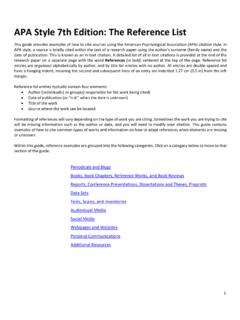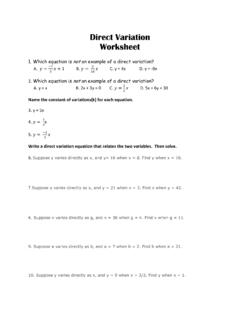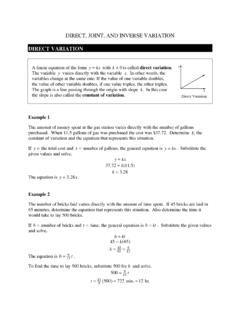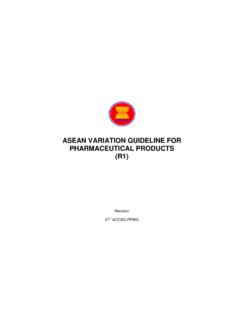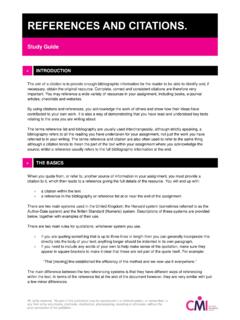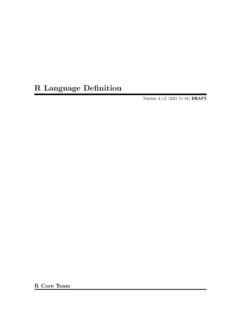Transcription of APA Style 7th Edition: In-Text Citations - Saint Mary's ...
1 1 APA Style 7th Edition: In-Text Citations The American Psychological Association (APA) citation Style is an author-date referencing system whereby sources are briefly identified within the text of a paper using the author s surname (family name), year of publication, and location reference ( , page number) at the point where the information is used. This is called an In-Text citation. All In-Text Citations have a corresponding entry in the reference list at the end of the paper. For help with how to prepare your reference list, please consult the Patrick Power Library guide: APA Style 7th Edition: The Reference List. There are two formats for In-Text Citations : parenthetical and narrative.
2 A parenthetical citation includes the author name and publication date in parentheses and can appear within or at the end of a sentence. In a narrative citation, the author name appears as part of the sentence and the date immediately follows in parentheses. You may also see both the author name and date incorporated into the text of the sentence, but this is less common. Examples: Parenthetical Citation: (Nichols, 2017) Narrative Citation: Nichols (2017) argued .. In 2017, Nichols argued .. In-Text Citations for Paraphrases and Quotations When quoting from a source, cite the author(s), year of publication, and page number in the In-Text citation using the parenthetical or narrative format.
3 If the work does not contain page numbers, use another method to indicate the location ( , a heading or section name, paragraph number, or a combination of both). Please refer to the section on Quotations for more information. When paraphrasing, cite the author(s) and the year of publication using the parenthetical or narrative forms of In-Text citation. APA Style does not require you to include page or paragraph numbers for paraphrases, but you may want to if it will help your reader to locate a specific passage. Some instructors may require that you always include a page or paragraph number when paraphrasing information from a specific location within a source.
4 Always check with your instructor if in doubt. The following examples briefly illustrate how to create In-Text Citations using APA Style (7th edition). More information and examples can be found in Chapter eight of the Publication Manual of the American Psychological Association, 7th ed. (call number: BF P83 2020). One author Two authors Three or more authors Group author with abbreviation Group author without abbreviation Unknown or anonymous author Work without a date Multiple works Secondary sources Personal communications Quotations Citing specific parts of a source Additional resources 2 One author Parenthetical Citation: The average citizen is wary of expert advice (Nichols, 2017, p.)
5 23). Narrative Citation: Nichols (2017) argued that the average citizen is wary of expert advice (p. 23). Note: APA does not require page numbers in In-Text Citations for paraphrased material, however, you may include them if it will help your reader to locate the specific passage. Two authors When a work has two authors, cite both authors in the first and all subsequent Citations . In parenthetical Citations use an ampersand (&) between names. In narrative Citations use the word and between names. Parenthetical Citation: Hospitalized patients reported improvements to mood following pet therapy visits (Coakley & Mahoney, 2009, p.
6 144). Narrative Citation: Coakley and Mahoney (2009) found that hospitalized patients reported improvements to mood following pet therapy visits (p. 144). Three or more authors When a work has three or more authors, include the first author s name only, followed by et al. in the first and all subsequent Citations . Examples: Parenthetical Citation: (Adams et al., 2014) Narrative Citation: Adams et al. (2014) Group author with abbreviation If the group or organization has a well-known abbreviation, you can abbreviate the name in the text. The first time the group is mentioned, provide the name in full followed by the abbreviation.
7 Use the abbreviation for subsequent mentions of the group. Parenthetical Citation: First citation: (Canadian Association of University Teachers [CAUT], 2020) Subsequent Citations : (CAUT, 2020) Narrative Citation: First citation: Canadian Association of University Teachers (CAUT, 2020) Subsequent Citations : CAUT (2020) 3 If you are citing two different groups that have the same abbreviation within your paper ( , both the American Psychological Association and the American Psychiatric Association abbreviate to APA ), provide the full name for each group every time you cite. Group author without abbreviation Parenthetical Citation: (Statistics Canada, 2020) Narrative Citation: Statistics Canada (2020) Unknown or anonymous author If the author of a work is unknown or cannot be determined, include the title and year of publication in the In-Text citation.
8 Capitalize major words in the title, and italicize the title if it is italicized in the reference list entry. If the title of the work is not italicized in the reference list entry, enclose the title in double quotation marks. Parenthetical Citation: ( Confirmation Bias, 2020) Narrative Citation: Confirmation Bias (2020) If the author of a source is identified as Anonymous , use Anonymous in place of the author name. Otherwise, if there is no author, use the title in the author position, as explained above. Parenthetical Citation: (Anonymous, 2013) Work without a date The date used in the In-Text citation should correspond to the publication date used in the reference list entry.
9 Only include the year in the In-Text citation, even if the reference list entry contains a more specific date ( , month and year). For references that have no date ( ), format the In-Text citation as follows: Parenthetical Citation: (Moreau, ) Narrative Citation: Moreau ( ) Multiple works For parenthetical Citations that contain two or more works by different authors, list the works alphabetically and separate them with a semi-colon. Multiple works that are incorporated into the narrative of a sentence, can appear in any order. Parenthetical Citation: (Gold et al., 2018; Murphy, 2012; Sun & Yang, 2016) Narrative Citation: Sun and Yang (2016), Gold et al.
10 (2018), and Murphy (2012) found that .. 4 If your citation contains two or more works by the same author, include the author s name only once, followed by the dates in chronological order. If the citation contains works by the same author and date, add a lowercase letter after the date. Parenthetical Citation: (Gonzalez, 2007, 2013) (Nazari, 2017a, 2017b) In multiple references where the first authors have the same surname, but different initials, include the first author s initials to avoid confusion. Parenthetical Citation: (K. Singh, 2018; M. Singh & Kumar, 2020) For more information about how to avoid ambiguity in In-Text Citations , please refer to Chapter eight, pp.


